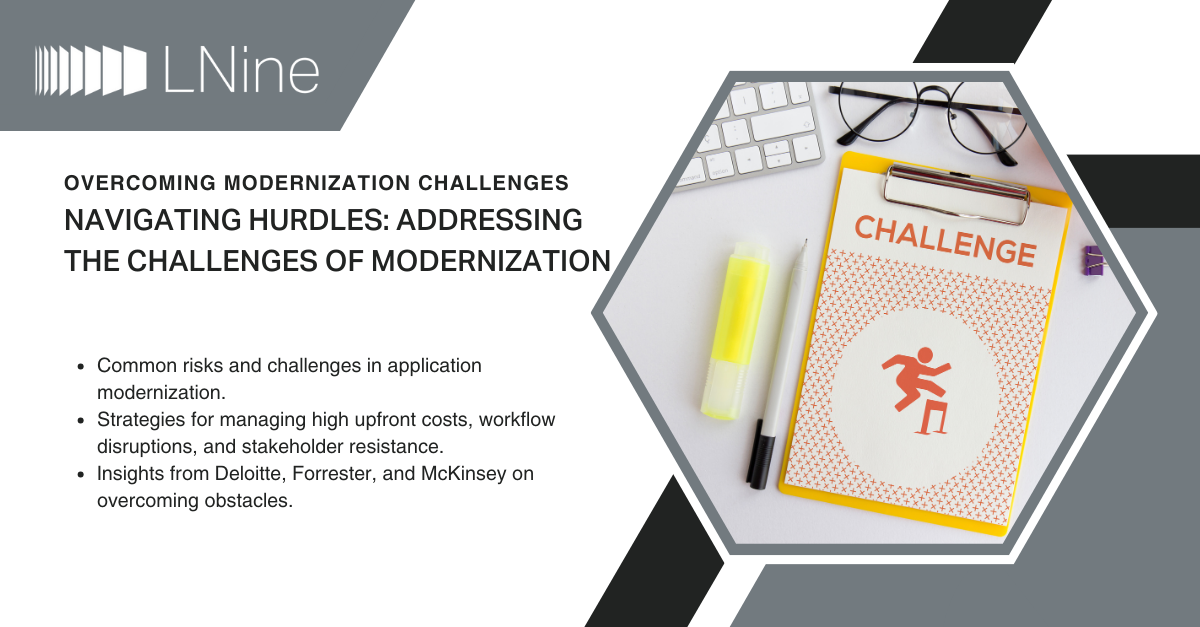The Modernization Imperative
In the race towards digital transformation, application modernization is not just a pit stop—it's a crucial refueling point. However, like any high-stakes race, the track is riddled with obstacles that can slow you down or even force you out of the competition. But fear not—with the right strategy and mindset, these hurdles can be overcome, propelling your organization towards the finish line of innovation and efficiency.
A sobering statistic from Deloitte sets the stage: 47% of organizations cite high upfront costs as a major challenge in their modernization efforts. This isn't just a speed bump—it's a formidable barrier that requires careful navigation.

Why It Matters
The challenges of modernization aren't just technical hiccups—they're strategic imperatives that can make or break your digital transformation journey. From financial hurdles to cultural resistance, each challenge represents a critical juncture where decisions made can ripple through your entire organization.
Overcoming these challenges isn't just about implementing new technology—it's about transforming your business from the inside out, ensuring it's equipped to thrive in the digital age.
Common Roadblocks: Understanding the Challenges
Before we can chart a course through the modernization maze, we need to understand the obstacles we're up against:
- The Cost Conundrum: High upfront costs can feel like a steep mountain to climb. It's not just about hardware and software—it's training, integration, and potential productivity dips during transition.
- Workflow Disruption: Modernization can be like changing the engine of a car while it's still running. The potential for disrupting existing business processes is real and can impact productivity if not managed carefully.
- The Human Factor: Resistance to change is as old as humanity itself. Employees and managers may view new systems and processes with skepticism or outright resistance.
- Integration Headaches: Trying to make modernized applications play nice with legacy systems can feel like forcing puzzle pieces from different sets to fit together.
- The Skills Gap: The shiny new tech is great, but who's going to operate it? The skills required for modern technologies may not exist within your current workforce.
Strategies for Success
Now that we've identified the dragons, here's how to slay them:
- Build a Bulletproof Business Case: Clearly articulate the long-term benefits and ROI of modernization. It's not just about convincing the C-suite—it's about creating a vision that the entire organization can rally behind.
- Embrace Incremental Progress: Rather than a "big bang" approach, take modernization one step at a time. It's like eating an elephant—you do it one bite at a time. This approach minimizes disruption and allows for course corrections based on early results.
- Stakeholder Engagement is Key: Involve stakeholders from day one. It's not just about informing them—it's about making them active participants in the modernization journey. Effective communication and change management aren't just nice-to-haves—they're critical success factors.
- Invest in Your People: Provide comprehensive training and support. Remember, your technology is only as good as the people using it. By equipping your team with the necessary skills, you're not just reducing resistance—you're creating modernization champions.
- Leverage the Cloud: Utilize cloud services that offer built-in integration tools and support for hybrid environments. It's like having a universal adapter for your tech ecosystem, simplifying the integration of modernized and legacy systems.
- Monitor, Optimize, Repeat: After modernization, the job isn't done—it's just beginning. Continuously monitor and optimize your applications to ensure they're delivering the expected benefits. Regular assessments and data-driven adjustments are key to long-term success.
The Payoff: Benefits of Overcoming Modernization Challenges
Successfully navigating the modernization maze isn't just about avoiding pitfalls—it's about unlocking transformative benefits:
- Cost Efficiency: While upfront costs can be high, successful modernization often leads to significant long-term savings in operational costs.
- Enhanced Agility: By overcoming integration challenges, organizations can create a more flexible, responsive IT environment.
- Empowered Workforce: Addressing the skills gap and resistance to change can result in a more engaged, productive workforce ready to leverage new technologies.
- Competitive Edge: Organizations that successfully modernize are better positioned to innovate and respond to market changes quickly.
The Road Ahead
Navigating the challenges of modernization isn't just a technical exercise—it's a strategic journey that can redefine your organization's future. While the path may be fraught with obstacles, the destination—a more agile, efficient, and innovative organization—is well worth the effort.
Remember, in the world of digital transformation, standing still is moving backward. The challenges of modernization aren't roadblocks—they're opportunities to differentiate yourself from the competition.
As you embark on or continue your modernization journey, keep this in mind: the organizations that thrive in the digital age won't be those that avoided challenges, but those that faced them head-on and emerged stronger on the other side.
Are you ready to turn your modernization challenges into your greatest competitive advantage?